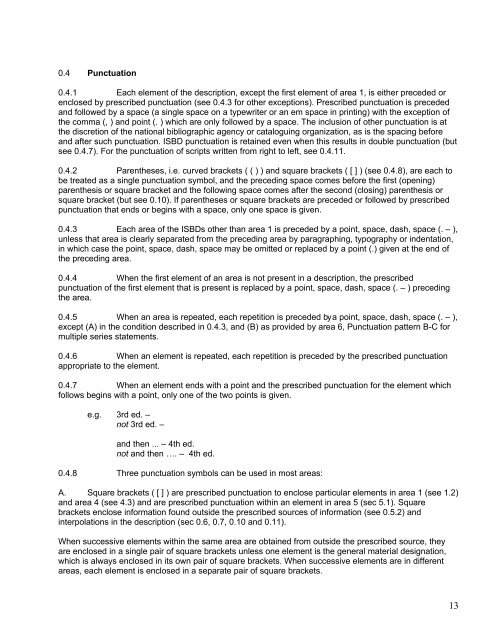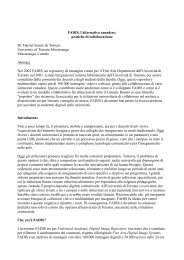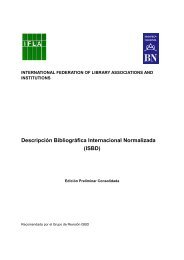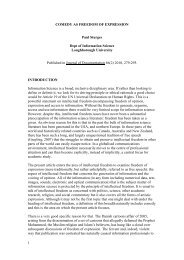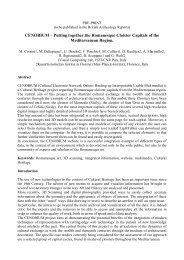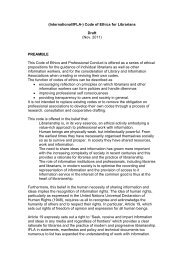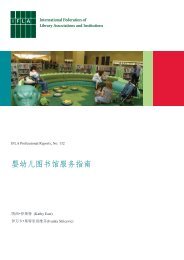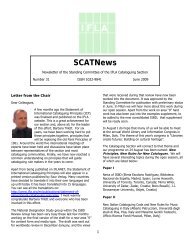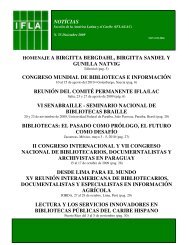ISBD(NBM) - IFLA
ISBD(NBM) - IFLA
ISBD(NBM) - IFLA
Create successful ePaper yourself
Turn your PDF publications into a flip-book with our unique Google optimized e-Paper software.
0.4 Punctuation<br />
0.4.1 Each element of the description, except the first element of area 1, is either preceded or<br />
enclosed by prescribed punctuation (see 0.4.3 for other exceptions). Prescribed punctuation is preceded<br />
and followed by a space (a single space on a typewriter or an em space in printing) with the exception of<br />
the comma (, ) and point (. ) which are only followed by a space. The inclusion of other punctuation is at<br />
the discretion of the national bibliographic agency or cataloguing organization, as is the spacing before<br />
and after such punctuation. <strong>ISBD</strong> punctuation is retained even when this results in double punctuation (but<br />
see 0.4.7). For the punctuation of scripts written from right to left, see 0.4.11.<br />
0.4.2 Parentheses, i.e. curved brackets ( ( ) ) and square brackets ( [ ] ) (see 0.4.8), are each to<br />
be treated as a single punctuation symbol, and the preceding space comes before the first (opening)<br />
parenthesis or square bracket and the following space comes after the second (closing) parenthesis or<br />
square bracket (but see 0.10). If parentheses or square brackets are preceded or followed by prescribed<br />
punctuation that ends or begins with a space, only one space is given.<br />
0.4.3 Each area of the <strong>ISBD</strong>s other than area 1 is preceded by a point, space, dash, space (. – ),<br />
unless that area is clearly separated from the preceding area by paragraphing, typography or indentation,<br />
in which case the point, space, dash, space may be omitted or replaced by a point (.) given at the end of<br />
the preceding area.<br />
0.4.4 When the first element of an area is not present in a description, the prescribed<br />
punctuation of the first element that is present is replaced by a point, space, dash, space (. – ) preceding<br />
the area.<br />
0.4.5 When an area is repeated, each repetition is preceded by a point, space, dash, space (. – ),<br />
except (A) in the condition described in 0.4.3, and (B) as provided by area 6, Punctuation pattern B-C for<br />
multiple series statements.<br />
0.4.6 When an element is repeated, each repetition is preceded by the prescribed punctuation<br />
appropriate to the element.<br />
0.4.7 When an element ends with a point and the prescribed punctuation for the element which<br />
follows begins with a point, only one of the two points is given.<br />
e.g. 3rd ed. –<br />
not 3rd ed. –<br />
and then ... – 4th ed.<br />
not and then …. – 4th ed.<br />
0.4.8 Three punctuation symbols can be used in most areas:<br />
A. Square brackets ( [ ] ) are prescribed punctuation to enclose particular elements in area 1 (see 1.2)<br />
and area 4 (see 4.3) and are prescribed punctuation within an element in area 5 (sec 5.1). Square<br />
brackets enclose information found outside the prescribed sources of information (see 0.5.2) and<br />
interpolations in the description (sec 0.6, 0.7, 0.10 and 0.11).<br />
When successive elements within the same area are obtained from outside the prescribed source, they<br />
are enclosed in a single pair of square brackets unless one element is the general material designation,<br />
which is always enclosed in its own pair of square brackets. When successive elements are in different<br />
areas, each element is enclosed in a separate pair of square brackets.<br />
13


